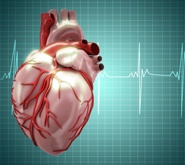Researchers solve 20-year puzzle of how heart regulates its beat
06 Jun 2013
Findings help explain what goes wrong in heart failure
A 20-year puzzle as to how the heart regulates contraction appears to have been solved by researchers from the University of Bristol. The findings, published in the journal Biophysics, paves the way to improving our understanding of what goes wrong when the heart fails.
 When the heart beats (contracts), the contractile machinery is switched on by an increase in calcium within the cell. This increase is produced by a release from intracellular stores activated by a small influx of calcium into the cell during the cardiac electrical signal - known as the action potential.
When the heart beats (contracts), the contractile machinery is switched on by an increase in calcium within the cell. This increase is produced by a release from intracellular stores activated by a small influx of calcium into the cell during the cardiac electrical signal - known as the action potential.
This apparently simple process raised an important question, since the trigger signal was smaller than the release and both involve calcium how could the system be graded – since once the release is started it should overcome the trigger signal and be fully regenerative.
A solution to this problem was found by Professor Mark Cannell from the University of Bristol's School of Physiology and Pharmacology and collaborators in the early 1990's - release takes the form of discrete microscopic calcium release events called 'calcium sparks'. It is the time-dependent recruitment of these events that allows the calcium release to be graded. So, although each microscopic event should be fully regenerative, the gradedness relies on each event being independent of all the others and each taking time to occur so that if the trigger is removed, the sites which have not yet produced a calcium spark will not fire.
However, this discovery did not explain how the calcium spark itself terminated and this problem has resisted out understanding since then. Many theories have been proposed but all invoked special properties for the release channels which are seen only under special experimental conditions.
A team of researchers led by Professor Cannell with Dr Laver from Hunter Medical Research Institute in Australia found a solution. Together, the team constructed a 3-dimensional computer model of the release machinery incorporating measurements of the calcium sensitivity of the release mechanism.
They found that the key to this puzzle is in the calcium dependence of the closed time of the channels that release calcium and the microscopic domain in which they reside. This model showed automatic release termination without having to invoke any other mechanism - a process they called 'induction decay'.
Therefore, a key piece of the puzzle as how the heart regulates contraction appears to have been solved, and this paves the way to improved understanding of what goes wrong when the heart fails - because there is good evidence that the calcium release mechanism becomes faulty in heart failure.
Professor Cannell said: ''These intracellular processes only occur on the molecular scale which is difficult, if not impossible, to image and study within living cells. Thanks to sophisticated computer modelling, we have been able provide the necessary insight into the complex behavior of this fundamental system.''













.jpg)






.jpg)









